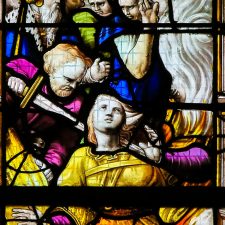In this article I will examine God’s purpose for giving the Decalogue and the Book of The Covenant. I will also compare the content and organization of the Decalogue and the Book of The Covenant. Finally, I will explain how the Decalogue and the Book of The Covenant are germane to the New Testament.
The Purpose of the Decalogue
God miraculously delivered the children of Israel from the land of Egypt. He wanted to establish a spiritual and formal affinity with the children of Israel. God established a covenant with the children of Israel through the leadership and the guidance of Moses. The covenant sets out how the people must live in order to be a holy nation.[1] The purpose of the Decalogue (Ex. 19:4-20:6) was to provide accountability to the covenant. The Decalogue places emphasis on the vertical affinity of loving God and the horizontal affinity of loving one’s neighbor.
The Purpose of the Book of The Covenant
The Book of the Covenant (Ex. 20:23-23:33) contains more punctilious responsibilities for the children of Israel. The responsibilities included laws that could be carry out by human courts, moral mores, principles about behavior, societal treatment of the impecunious and the observance of spiritual duties. The purpose of the Book of The Covenant is setting punctilious responsibilities for the children of Israel to live in loyalty and obedience unto Yahweh.
The Content of The Decalogue and The Book of the Covenant
The content of both documents reveals the holiness and standards of God. Both documents emphasize God’s desire to enter into covenant with the children of Israel. The documents have principle responsibilities that God requires to remain in covenant with Him. The Decalogue responsibilities are a panoramic view of God’s mores. But the Book of the Covenant is a close-up view of God’s mores. Both documents require the children of Israel to live a life pleasing to God and to one’s neighbor.
The Organization of The Decalogue and The Book of the Covenant
The organization of the Decalogue was based on absolutes not non-sequiturs. “Apodictic law refers to timeless divine commands and not to ‘law applied.’ Thus, it is ‘necessarily or demonstrably true; incontrovertible; clearly established or beyond dispute’ since it is divinely revealed). This is so because it is not directly related to any necessary historical situation (Thou shalt, Thou shalt not; i.e., the Ten Commandments).”[2] The organization of the Book of the Covenant was based on a caustic model “if and then” statement. The Bible Tools Study website gives a cogent analysis of The Book of the Covenant.
“(1) directions concerning worship, specifying prohibition of images and the form of altar for animal sacrifices (Exodus 20:23-26);
(2) ordinances for protection of Hebrew slaves, including betrothal, for a price, of daughter (Exodus 21:2-11);
(3) laws concerning injuries,
(a) to man by man (Exodus 21:12-27),
(b) to man by beast (Exodus 21:28-32),
(c) to beast by man (Exodus 21:33,14),
(d) to beast by beast (Exodus 21:35,36);
(4) concerning theft (Exodus 22:1-4);
(5) concerning damage to a neighbor’s property, including violence to his daughter (Exodus 22:5-17);
(6) sundry laws against profaning Yahweh’s name, under which are included proper worship, avoidance of oppression and dutiful offering of first-fruits (Exodus 22:18-31);
(7) against various forms of injustice and unbrotherliness (Exodus 23:1-9);
(8) festal occasions, including the Sabbatical year and the three annual feasts: unleavened bread, first-fruits and ingathering (Exodus 23:10-17);
(9) warning against certain wrong practices in their sacrifices (Exodus 23:18,19);
(10) in conclusion, a promise of God’s continual presence with them in the person of His Angel, and the consequent triumph over enemies (Exodus 23:20-33).”[3]
The Decalogue and The Book of the Covenant Applicability to The New Testament
Throughout Christendom there has been rigorous debate over the applicability of Decalogue and the Book of the Covenant to the New Testament. The biblical narrative promotes confluence and harmony. “The law cannot be altogether invalid since the New Testament affirms its abiding applicability. ‘All Scripture is … useful’ (2 Tim. 3:16–17), including Old Testament laws. Jesus came not to abolish the law, but to fulfill it (Matt. 5:17–20). The law is the embodiment of truth that instructs (Rom. 2:18–19). It is ‘holy’ and ‘spiritual,’ making sin known to us by defining it; therefore, Paul delights in it (Rom. 7:7-14, 22). A careful examination of the use of the word ‘law’ demonstrates the answer. Certain laws that dealt with Old Testament ceremonial life (‘Ceremonial Laws’) were fulfilled in Christ. Other laws, relating to the time of Moses, when Israel had no king but God, have been called, ‘Civil Laws’ (or, sometimes, ‘Theocratic Laws;’ because Israel was a theocracy, with God as head of the human government). The other category of ‘law’ in the Bible is that critical code of living that is before us in this article: The Ten Commandments. Those commandments form a ‘Moral Law’ that continues to this day.”[4]
Robert Caruth Jr, a native of Peoria, accepted Christ at the age of 14. He had a penchant for learning the word of God early on in his Christian journey. This proved to be the capstone solidifying his walk with the Lord. Pastor Caruth has been married to Melanie Caruth for 35 years. This conjugal union has produced their only child Fallon who is a miracle from the Lord. Pastor Caruth earned a Bachelor of Science in Biblical Studies from Moody Bible Institute in Chicago, Illinois. He is currently finishing up his Masters Degree at Moody Theological Seminary. He serves as the teaching pastor and visionary leader of The Church of Living God Community Church in Richmond Heights, Missouri.
REFERENCES
[1] T.D. Alexander, From Paradise to the Promise Land: An Introduction to the Pentateuch 3rd ed. (Grand Rapids: Baker Academic, 2012), 209.
[2] Biblical Studies Foundation, Can You Describe Apodictic Law As It Applies The OT Law {website}, https://bible.org/question/can-you-describe-apodictic-law-it-applies-ot-law, (accessed 14 February 2020)
[3] James Orr, General Editor. “Entry for ‘COVENANT, BOOK OF THE’“. “International Standard Bible Encyclopedia”. 1915. Covenant, Book Of the {website}, https://www.biblestudytools.com/dictionary/covenant-book-of-the/ , (accessed 14 February 2020)
[4] Michael M. Milton, The 10 Commandments: What Are They & Are They Still Relevant? {website}, https://www.biblestudytools.com/bible-study/topical-studies/the-ten-commandments-what-are-they-and-are-they-still-relevant.html , (accessed on 15 February 2020)













